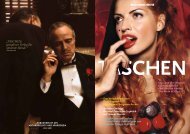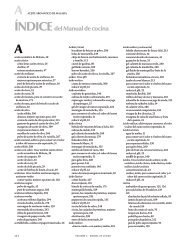“TASCHEN: wonderful publisher of sumptuous tomes.”
“TASCHEN: wonderful publisher of sumptuous tomes.”
“TASCHEN: wonderful publisher of sumptuous tomes.”
You also want an ePaper? Increase the reach of your titles
YUMPU automatically turns print PDFs into web optimized ePapers that Google loves.
TRUE CRIME DETECTIVE MAGAZINES<br />
Sin, cigarettes<br />
and stiletto heels<br />
By Eric Godtland<br />
Any screenwriter will tell you,“The only thing every<br />
good movie script must have is sex and violence<strong>”</strong>. Which<br />
is to say life. Sex and violence represent the two peaks <strong>of</strong><br />
human passion, man’s greatest desire and direst fear, the<br />
best and worst <strong>of</strong> human existence, our beginning and<br />
our end. Perhaps this is why the combination <strong>of</strong> sex and<br />
violence is such a potent and irresistible taboo, not just<br />
the bones <strong>of</strong> a good film script, or a constant on the<br />
nightly news, but the basis for most entertainment today.<br />
It was crime and passion that led the<br />
illiterate to buy newspapers; sex and<br />
violence that made them want to learn<br />
to read<br />
We’re so used to feasting on the media’s sex and violence<br />
stew we assume it has been this way forever, but mass<br />
media, born with the newspaper, is a relatively new<br />
development. 150 years ago newspapers were the province<br />
<strong>of</strong> the educated elite, providing the sort <strong>of</strong> sober coverage<br />
needed to keep the peasants in their place. It took pictures<br />
to capture the attention <strong>of</strong> the largely illiterate working<br />
class, the sort <strong>of</strong> pictures that made a visceral and immediate<br />
impact. Can anybody guess what kind <strong>of</strong> pictures<br />
these were?<br />
It was crime and passion that led the illiterate to buy<br />
newspapers; sex and violence that made them want to<br />
learn to read, and one <strong>of</strong> the most important bridges<br />
leading from the original elite media to the current<br />
events cacophony <strong>of</strong> today was the detective magazine.<br />
This genre was the first to artfully sensationalize all the<br />
prurient themes with which we are bombarded today.<br />
What caused the detective genre to suddenly spring up in<br />
the mid-19th century? The cylinder printing press invented<br />
in 1811 helped bring news from outside the neighborhood<br />
to the metropolitan rabble. During the 1830s further<br />
advances produced a “penny press<strong>”</strong>, so named<br />
because it could turn out broadsheets cheaply enough to<br />
be sold pr<strong>of</strong>itably for a penny. Newspapers were suddenly<br />
within the means <strong>of</strong> most and began covering subjects <strong>of</strong><br />
interest to a previously ignored group <strong>of</strong> readers: the<br />
working class. True crime coverage was quickly found to<br />
be a favorite with this newly literate sector. As both literacy<br />
and print technology further improved the western<br />
world experienced a newspaper boom.<br />
For America this print revolution coincided with an<br />
urban crime wave. In the big Eastern cities, New York in<br />
particular, crime proliferated within the hungry, packedin,<br />
largely immigrant neighborhoods. With the rapid<br />
population growth people not only ceased to know their<br />
neighbors, they didn’t know their neighbor's language,<br />
traditions or social ways. With so many strangers and<br />
strange cultures thrown together, the fear grew beyond<br />
gossip’s ability to convey it. It was within this climate <strong>of</strong><br />
crime and fear <strong>of</strong> crime that true crime reporting began<br />
in earnest.<br />
Technically, the first true crime titles were born in 1924<br />
when New York-based Macfadden introduced True<br />
Detective Mysteries, and an undistinguished pulp called<br />
Detective Tales was sold to a <strong>publisher</strong> in Chicago and<br />
reborn as Real Detective Tales. Both these new titles were<br />
largely fiction-based for the first four years <strong>of</strong> their runs,<br />
as they had been designed to compete with Detective<br />
Story Magazine and new competitors The Black Mask<br />
and Flynn’s. Ironically, the only magazine experimenting<br />
with true crime stories at all during this period was<br />
Flynn’s, the least popular <strong>of</strong> the three.<br />
Around 1928 both True Detective Tales and Real<br />
Detective Tales split from the crime fiction genre.<br />
Although both had previously featured stories based<br />
around real crime, they’d held back on actual names,<br />
photos and explicit details. Gradually, though, both<br />
became emboldened to cover real crime alongside the<br />
fiction. True Detective showed more daring, moving to a<br />
completely true crime format by 1929. Real Detective,<br />
having changed its title to the clumsy Real Detective<br />
Tales & Mystery Stories in 1927, continued mixing fiction<br />
with reality until 1931.<br />
Magazines could confer instant fame on<br />
their featured criminals. They were “star<br />
makers<strong>”</strong> in a near Hollywood sense<br />
Why the shift? One answer would be that the competition<br />
for good writers and stories was fierce, but it is more<br />
likely that someone, Macfadden or his editor John<br />
Shuttleworth, finally noticed that what was going on in<br />
the streets and speakeasies was even more entertaining<br />
than fiction.<br />
Detective magazines exploded in popularity in the 1930s<br />
thanks to a synergistic triad <strong>of</strong> trends: the proliferation <strong>of</strong><br />
home radio sets, the national crime wave generated by<br />
prohibition, and the escapist yearnings <strong>of</strong> a public mired<br />
in the Great Depression. Radio had flowered in the 1920s<br />
and continued to blossom through the ‘30s, with 638 stations<br />
in 1930, growing to 909 by 1942. By the end <strong>of</strong> the<br />
decade over 80% <strong>of</strong> American households owned a radio.<br />
This medium that brought live news coverage to all parts<br />
<strong>of</strong> the country simultaneously changed the idea <strong>of</strong> what<br />
“up on the news<strong>”</strong> meant. Radio transformed reporting,<br />
and especially crime reporting, into a form <strong>of</strong> entertainment.<br />
For the first time people could follow the exploits<br />
<strong>of</strong> bank robbers, gangsters and other shadowy characters<br />
at work, at home, in barbershops and bars, with the exciting<br />
urgency <strong>of</strong> hour by hour reports.<br />
All this crime and chaos was a tremendous boon to the<br />
detective magazine <strong>publisher</strong>s, mainly Macfadden, Real<br />
Detective Tales Inc, and Fawcett, who fell over themselves<br />
to provide the kind <strong>of</strong> photos, interviews, and illustrations<br />
that only crime magazines could provide. During<br />
this golden age the magazines could confer instant fame<br />
on their featured criminals. They were “star makers<strong>”</strong> in a<br />
near Hollywood sense for John Dillinger, Al Capone,<br />
Bonnie Parker and Clyde Barrow, Ma Barker, Pretty Boy<br />
Floyd, Alvin Karpis, Machine Gun Kelly and Baby Face<br />
Nelson, who rank among the most recognizable names<br />
“You can get farther with a<br />
kind word and a gun than you can<br />
with a kind word alone.<strong>”</strong><br />
—AL CAPONE, AMERICAN GANGSTER<br />
in criminal history thanks to the detective magazines.<br />
Dillinger holds top honors as America’s all-time most<br />
popular criminal, with Capone close behind. In their day<br />
they had as many fans as the film stars <strong>of</strong> the era, and<br />
Hollywood kept close tabs on the detective magazines for<br />
plot ideas. Scarface (1932), patterned after the career <strong>of</strong> Al<br />
Capone, went into production less than a year after the<br />
gangster’s 1931 income tax evasion bust. Actors played<br />
mobsters during the day and drank beside real gangsters<br />
in the clubs at night. Actress Virginia Hill took the symbiosis<br />
to the limit when she hooked up with Ben “Bugsy<strong>”</strong><br />
Seigel. He was a gangster, she an actress. He tried to get<br />
into films, while she embezzled from him. Can anyone<br />
deny the detective magazines <strong>of</strong> the 1930s fueled this artimitates-life-imitates-art<br />
scenario?<br />
In 1950 the vision <strong>of</strong> a smoking, wisecracking,<br />
gorgeous whore in a slit skirt<br />
spelled major trouble<br />
The detective magazines entered the ‘40s flush with success<br />
and optimism, not knowing they were just two years<br />
from the end <strong>of</strong> their golden reign. With the bombing <strong>of</strong><br />
Pearl Harbor and America’s entrance into World War II<br />
they confronted two insurmountable obstacles that<br />
would bring about great change.<br />
First, domestic crime lost its sparkle. Prohibition was<br />
repealed at the end <strong>of</strong> 1933 and when organized crime’s<br />
cash cow dried up the sensational turf battles, hits and<br />
general corruption began winding down. By 1940 the<br />
mob was rarely front-page news.<br />
The second blow was wartime paper rationing, which<br />
would forever change detective magazines for the worse.<br />
Government-mandated rationing forced most titles to<br />
switch to pulp paper and many titles to cease publishing<br />
for the duration, and in some cases for good. The most<br />
ruinous decision the <strong>publisher</strong>s made was to stick with<br />
the pulp after the rationing ended. As <strong>publisher</strong>s became<br />
accustomed to the savings <strong>of</strong> cheap paper they looked for<br />
other ways to economize. Less was spent on crime<br />
research and the magazines became not only less attractive<br />
but less relevant.<br />
Then in January <strong>of</strong> 1947 a crime occurred that foreshadowed<br />
the direction <strong>of</strong> the genre for the remainder <strong>of</strong> its<br />
life span. The Black Dahlia murder case, in which the<br />
naked and mutilated body <strong>of</strong> a beautiful Hollywood starlet<br />
was found in a vacant lot in Los Angeles, riveted the<br />
detective readership. Horrible as it all was, the obvious<br />
sex appeal lurking in the back-story <strong>of</strong> this case was not<br />
lost on <strong>publisher</strong>s struggling to hold a shrinking readership.<br />
Before the decade ended most titles had switched to<br />
stories with prurient fascination and were playing up the<br />
sexual angle in every possible crime.<br />
For the collector <strong>of</strong> over-the-top, flagrantly sexual<br />
imagery the late 1940s through the 1950s represent the<br />
pinnacle for the detective titles. Earlier magazines were<br />
more beautifully printed, better written and featured<br />
cover art by fine artists, but not until the 1950s was the<br />
Bad Girl detective archetype refined to an icon.<br />
Opposite: from left to right: Women in Crime,<br />
July 1949; Sensation, February 1942; All-Fact Detective,<br />
March 1943 Right: True Detective, March 1966<br />
Women in Crime, Crime Girls, Women on Trial, Ladies<br />
<strong>of</strong> the Underworld, Crime Confessions, Girl Spies,<br />
Sensational Exposés and Vice Squad were just a few <strong>of</strong><br />
the femme fatale-baited ‘50s titles drilling home the<br />
concept <strong>of</strong> woman as temptress. In 1950 the vision <strong>of</strong> a<br />
smoking, wisecracking, gorgeous whore in a slit skirt<br />
and breast-hugging sweater (or, better yet, a taxi dancer’s<br />
striped Bohemian leotard!) spelled major trouble. With<br />
full, flowing hair and the occasional beatnik beret, this<br />
tart and her pals glared defiantly from police line-ups,<br />
conned suckers in seamy bars and brandished the justfired<br />
pistol at countless murder scenes. Even when she<br />
morphed into a teenage delinquent late in the decade<br />
she was all too alluring in her dungarees and leather<br />
jacket, lip curled with disdain, bouffant jutting skyward<br />
| 36 | “Half the crooks in this prison are here because they associated with some moll. Never trust a woman, my boy.<strong>”</strong>—TRUE DETECTIVE MYSTERIES, May 1928<br />
TRUE CRIME DETECTIVE MAGAZINES<br />
as the cops led her away. What was her crime? You<br />
name it, Joe. These dolls were guilty <strong>of</strong> everything from<br />
hanging around with JD hot rod rumblers to swinging<br />
hard at hophead parties. And don’t even bother to ask<br />
why a beautiful, former choirgirl would be drawn to this<br />
degenerate underworld <strong>of</strong> crime and depravity. A mature<br />
man <strong>of</strong> the ‘50s, the typical detective magazine reader,<br />
knew the answer all too well. If not held tight in a<br />
restraining moral grip, if not penned at home by<br />
marriage, children and church, if not hogtied with<br />
girdles and aprons and single strands <strong>of</strong> ladylike pearls,<br />
any woman was capable <strong>of</strong> anything. One slip <strong>of</strong> the<br />
moral order and we’d be right back in Eden, one snake<br />
hiss away from disaster. Just ask the preacher man, my<br />
friend — all women are bad.






